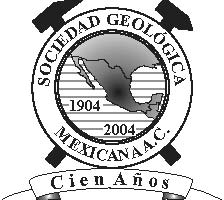|
BOLETÍN DE LA SOCIEDAD GEOLÓGICA MEXICANA VOL. 59, NÚM:. 1, 2007, p. 1-7 http://dx.doi.org/10.18268/BSGM2007v59n1a1 |
 |
The first geologic map of Sonora
Max Suter
Instituto de Geología, Universidad Nacional Autónoma de México, Estación Regional del Noroeste,
Apartado Postal 1039, C. P. 83000 Hermosillo, Sonora, México
This email address is being protected from spambots. You need JavaScript enabled to view it.
Abstract
The 1888 publication by José Guadalupe Aguilera Serrano about the 3 May 1887 Sonora, Mexico earthquake contains the earliest geologic map of Sonora, a 1:1,000,000 scale color map with six cartographic units, reproduced in this paper. On the map,which covers ~20, 000 km2 of northeastern Sonora, and in the accompanying article, Aguilera delimited and described parts of what is now known as the Jaralito and Oposura batholiths and assigned them, remarkably, an Eocene age. The map unit of volcanic rocks belongs mostly to the vast cover of the middle Tertiary Sierra Madre Occidental volcanic province and the units of Pliocene and Quaternary rocks to the fill of extensional basins. Aguilera assigned a Quaternary age to the basalt flows in the Moctezuma and San Bernardino valleys, which he described as covering the alluvium of these valleys. The rocks of the Pliocene map unit were described by Aguilera as an indurated conglomerate dipping 20°S, overlain with angular unconformity by alluvium, and most of its clasts being of volcanic origin; this unit is now known as the Báucarit Formation of Mioceneage. The Cretaceous map unit, described by Aguilera as ash grey, compact, and fossiliferous limestone beds belonging very probably to the Comanche series, is now known as the Lower Cretaceous Mural Limestone. Aguilera's map covers a series of north-south trending mountain ranges separated by the Moctezuma, Bavispe, San Bernardino, Fronteras, and Agua Prieta River valleys, a landscape pattern typical of the Basin and Range physiographic province. Aguilera described this transition zone between the plateau of the Sierra Madre Occidental in the east and the lowlands in the west as a large-scale staircase pattern, with the steep, fault-bounded side of the mountain ranges always facing west. A rare photograph by Camillus S. Fly possibly shows Aguilera and his field party near Bavispe, Sonora in August 1887.
Keywords: José Guadalupe Aguilera Serrano [1857-1941], history of geology, geologic map, Sonora, Mexico, Basin and Range province, Sonoran batholith

